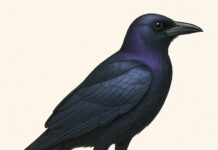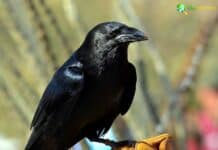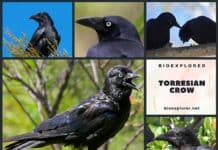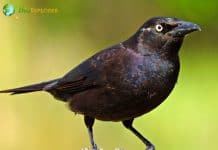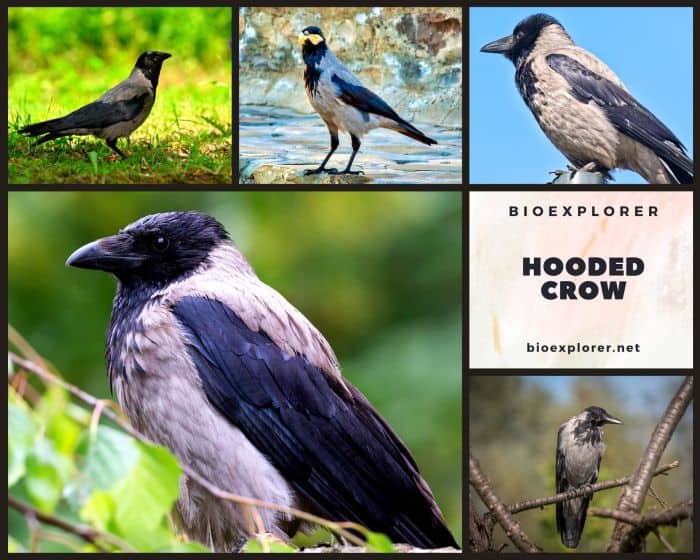
| Animalia | Aves | Passeriformes | Corvidae | Chordata | Corvus cornix |
Table of Contents
- Hooded Crow Physical Characteristics
- Hooded Crows are socially adaptable
- Hooded Crows are quite aggressive
- Hooded Crows have theft habits
- Hooded Crows as Pets
- Frequently Asked Questions
- What’s the difference between a crow and a hooded crow?
- Are hooded crows endangered?
- What does a hooded crow look like?
- Are hooded crows common?
- What does the hooded crow symbolize?
- What are some interesting facts about the hooded crow?
The hooded crow (Corvus cornix) is a bird species belonging to the Corvus genus. It is widely distributed across Northern, Eastern, and Southeastern Europe and parts of the Middle East. The hooded crow is an ashy grey bird with a black head, throat, wings, tail, thigh feathers, black bill, eyes, and feet.
Like other corvids, it is an omnivorous and opportunistic forager and feeder. The hooded crow is so similar in morphology and habits to the carrion crow (Corvus corone) that for many years they were considered by most authorities to be geographical races of one species.
However, since 2002, the hooded crow has been elevated to full species status after closer observation.
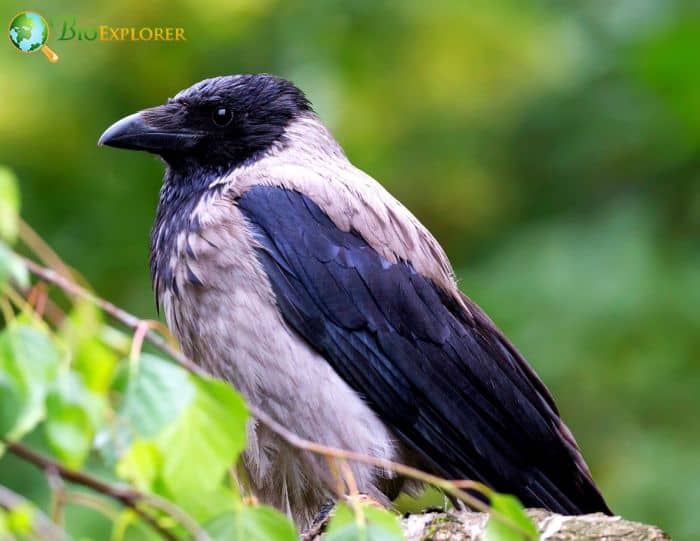
Hooded Crow Physical Characteristics
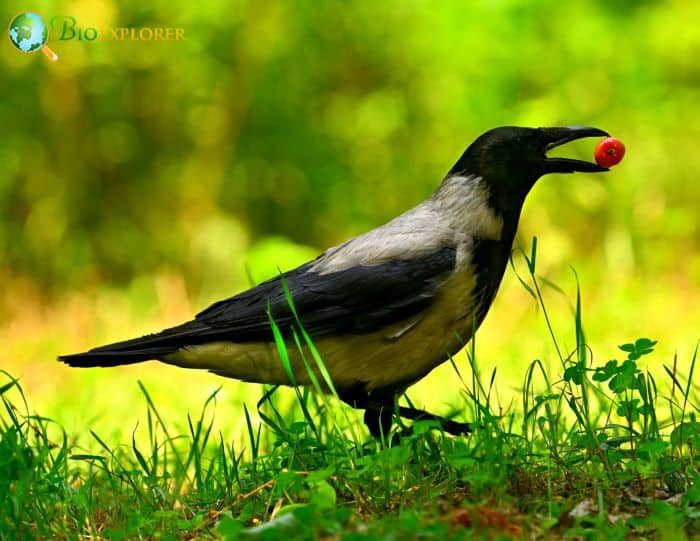
The hooded crow is a large corvid bird species easily recognizable by its strikingly contrasting plumage. Here are some of its physical characteristics:
- The hooded crow has an ashy grey body, belly, nape, and rump contrasting with a black head, bib, wings, and tail[1].
- It has dark grey legs and dark brown eyes.
- Female hooded crows are slightly smaller than males, but their coloring and plumage are similar. Only their behavior can be used to distinguish them from males.
- Juvenile hooded crows have duller grey feathers with a browner tint than adults.
- The beaks of immature hooded crows are pinkish-red on the inside instead of the dark grey of adult birds. They also have blue-grey eyes.
- Overall, the hooded crow’s physical characteristics make it a distinctive and easily recognizable bird species.
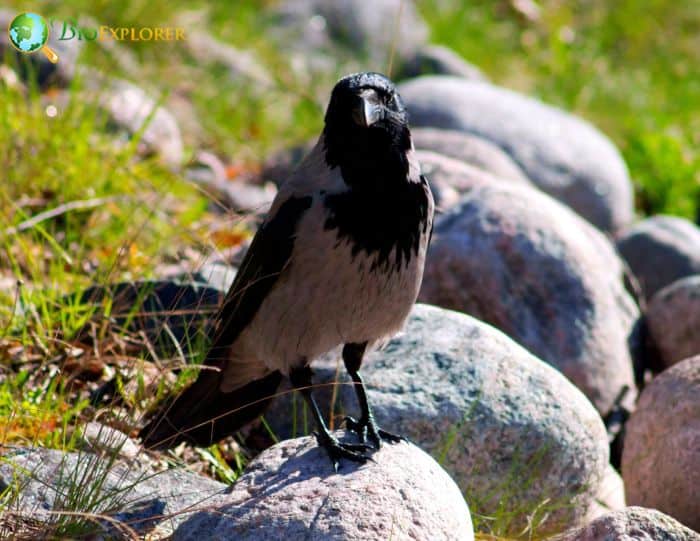
The hooded crow is a socially flexible animal. As a result, they can quickly establish a strong bond with their owners.
- A pet hooded crow’s intelligence and cunning enable it to understand its owners’ instructions.
- These black birds occasionally exhibit hostility[2] and depression due to their owners’ rudeness.
- Taking care of their diet presents another significant challenge because they primarily consume insects and meat from dead animals.
Suggested Reading:
Explore Top 14 Texas Birds With Their Identifications
Hooded Crows are quite aggressive
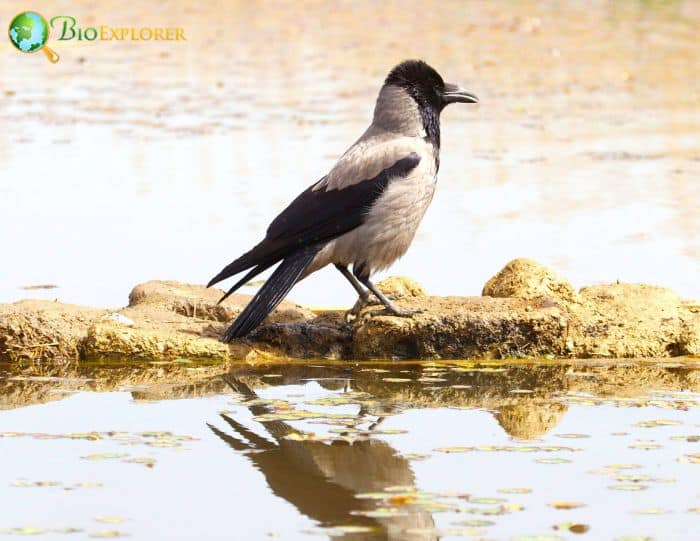
These crows can occasionally display aggressive behavior and flee from nearly anything that makes contact with their beak.
Additionally, these crows should interact with people every day to keep them under control. They are not to be trusted, though, as their beak can act as a weapon and inflict serious harm.
Suggested Reading:
15 Amazing Birds of Colorado
Hooded Crows have theft habits
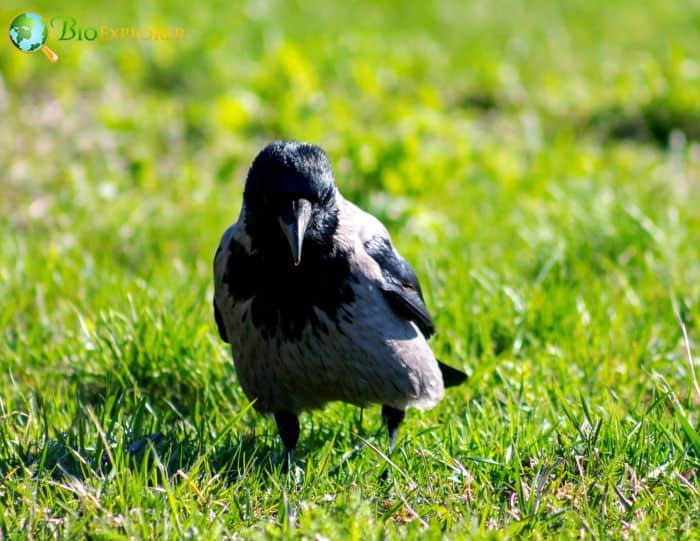
Hooded crows are expert egg robbers. They will observe and examine how other birds build their nests as they do so. Once the eggs have been laid, the crow will find it much simpler to rob the nest.
These dark aviators are very opportunistic and will watch other birds feed their young before swooping in to steal it.
Suggested Reading:
Marvellous Birds of Massachusetts
Hooded Crows as Pets
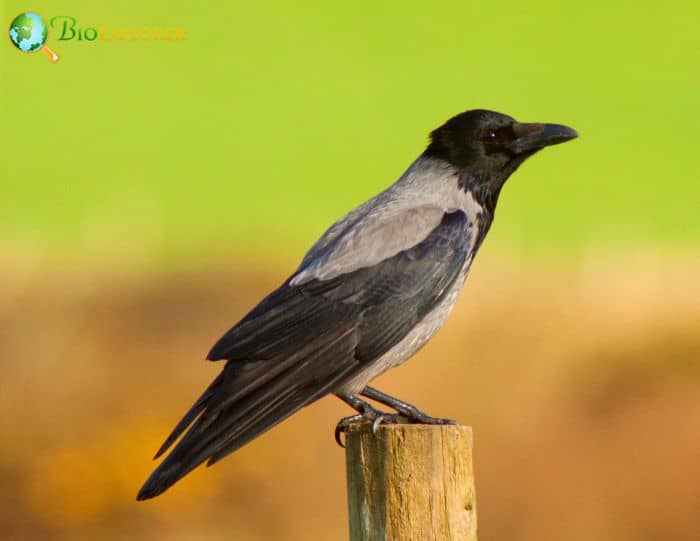
The hooded crow is a skilled mimic, easily imitating sounds and words.
- Naturally social, crows form close relationships with their owners and may even pick up simple commands.
- Even though they can grow quite brash-free-ranging pets frequently torment dogs, cats, and guests-their great intelligence is matched by a sensitive nature. Despite their tough exterior, Hooded Crows are easily upset by rude behavior[3].
The crow family includes crows, rooks, and ravens, all of which can be challenging to distinguish.
Suggested Reading:
Top 15 BEST Birds of Missouri
Frequently Asked Questions
What’s the difference between a crow and a hooded crow?

The hooded crow (Corvus cornix) and the carrion crow (Corvus corone) are two closely related bird species that are almost identical genetically. However, there are distinct physical and behavioral differences between them[4].
- Regarding physical characteristics, the hooded crow has an ashy grey body, belly, nape, and rump, contrasting with a black head, bib, wings, and tail. On the other hand, the carrion crow is solid black in color. Immature hooded crows have pinkish-red beaks, while immature carrion crows have grey beaks.
- Juvenile hooded crows have blue-grey eyes, while juvenile carrion crows have brown eyes. Female hooded crows can be visually distinguished from males by size and behavior. On the other hand, female carrion crows are slightly smaller than males and have a less bulky bill.
- Regarding behavior, hooded crows are more friendly and often live in pairs or small groups. They exhibit a preference for mates whose coloring matches theirs.
- Conversely, carrion crows are less sociable and exhibit dominant behaviors influenced by hormones. Like hooded crows, they also choose mates based on coloring similarity.
Overall, while the hooded crow and the carrion crow are closely related and share many similarities, the two species have noticeable physical and behavioral differences.
Are hooded crows endangered?
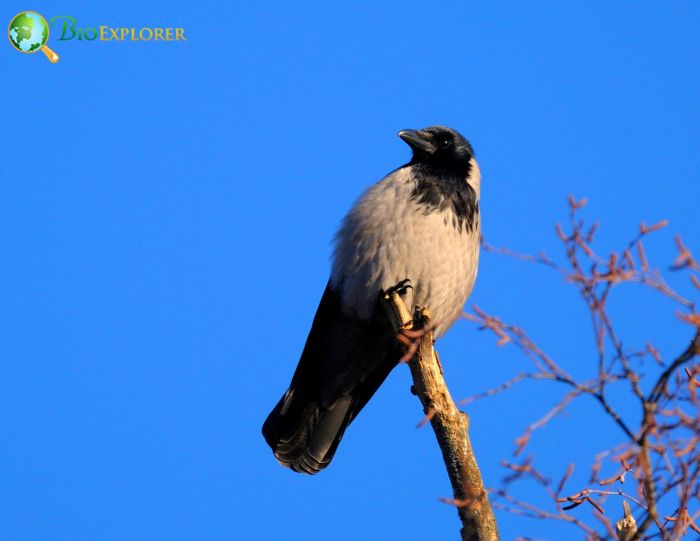
The hooded crow is not considered a species of concern, and no specific conservation actions are currently needed for its population.
In the United Kingdom, the hooded crow is protected under The Wildlife and Countryside Act 1981, reflecting its conservation status as “Green“, indicating no immediate threat to its survival[5].
In Europe, the hooded crow is considered a “Least Concern” regarding its conservation status. This designation suggests that the species is widespread and stable throughout its range and does not face significant threats to its population.
Overall, the hooded crow is not considered endangered, and its conservation status is generally stable. However, ongoing monitoring and conservation efforts are important to ensure the continued well-being of the species and its habitats.
What does a hooded crow look like?
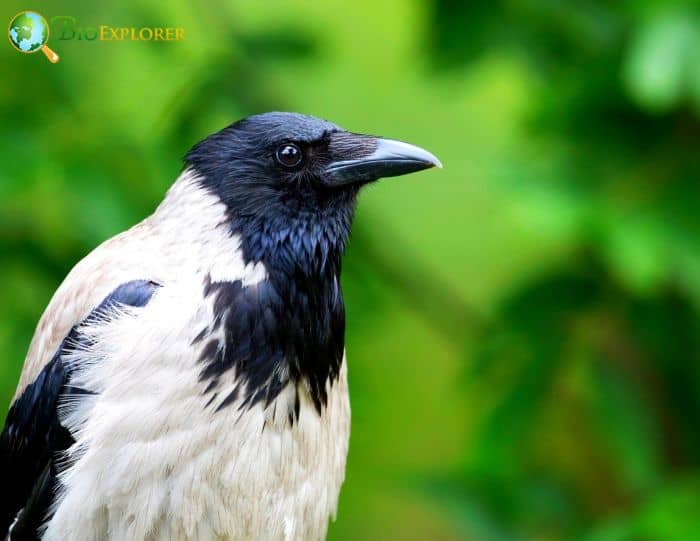
The hooded crow is a distinctive bird with the following appearance:
- Size and Measurements: It measures around 46cm (18 inches) in length. It has a moderate size compared to other crow species.
- Plumage: The hooded crow has an ashy grey color on its back and lower body. Its head, throat, wings, and tail are black, creating a sharp contrast. The feathers on its thighs are also black.
- Facial Features: It has dark brown eyes and a thick, curved beak, characteristic of the crow species. The beak is black, like the rest of its face.
- Sexual Dimorphism: Male and female hooded crows have similar appearance. However, female hooded crows may be slightly smaller and behave differently than males.
- Juvenile Plumage: Juvenile hooded crows have duller grey feathers with a hint of brown compared to adults. Their beaks have a pinkish-red color on the inside. Their eyes are blue-grey.
- Contrast with Carrion Crow: The hooded crow can be distinguished from the carrion crow by its combination of ashy grey and black plumage. The carrion crow is entirely black.
The hooded crow stands out with its ashy grey body, black head, throat, wings, tail, thighs, black bill, eyes, and feet. These distinct features make it easily identifiable in the bird kingdom.
Are hooded crows common?
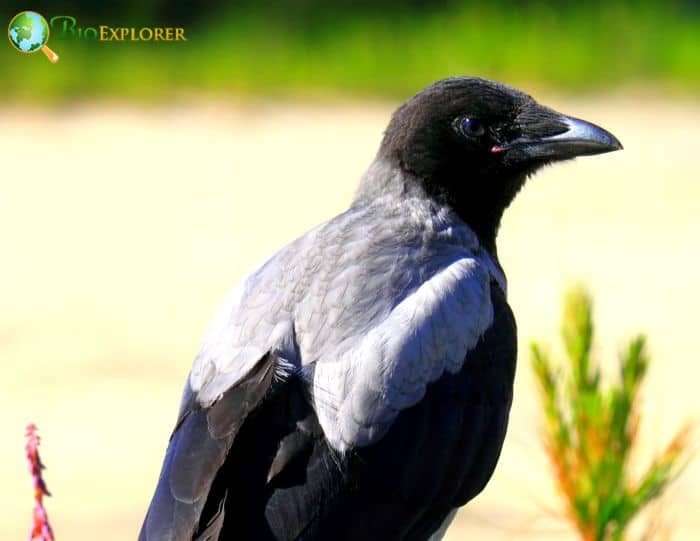
The hooded crow is a common bird species in many parts of Europe and the Middle East, and it benefits from the proximity of humans.
What does the hooded crow symbolize?
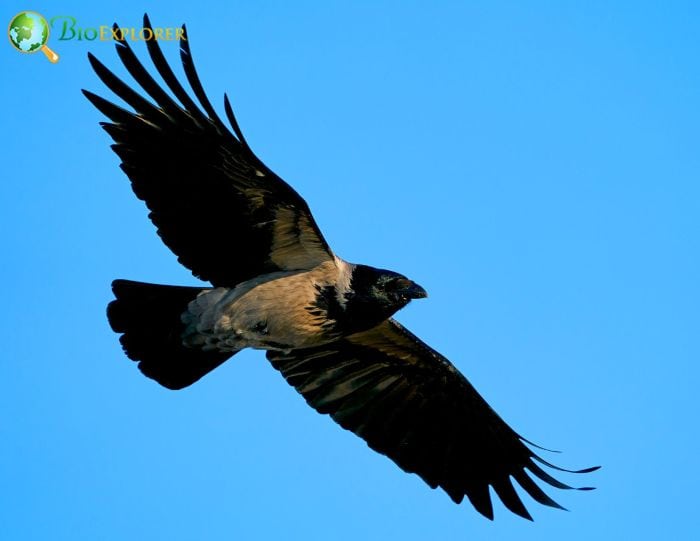
No clear symbolic meaning is associated with the hooded crow in popular culture or mythology. However, here are some details about the hooded crow:
- In Irish folklore, the bird appears on the shoulder of the dying Cú Chulainn[6] and could also be a manifestation of the Morrígan, a goddess of war and fate.
Overall, while the hooded crow does not have a clear symbolic meaning, it is a widely distributed bird species that is adaptable and benefits from the proximity of humans.
What are some interesting facts about the hooded crow?
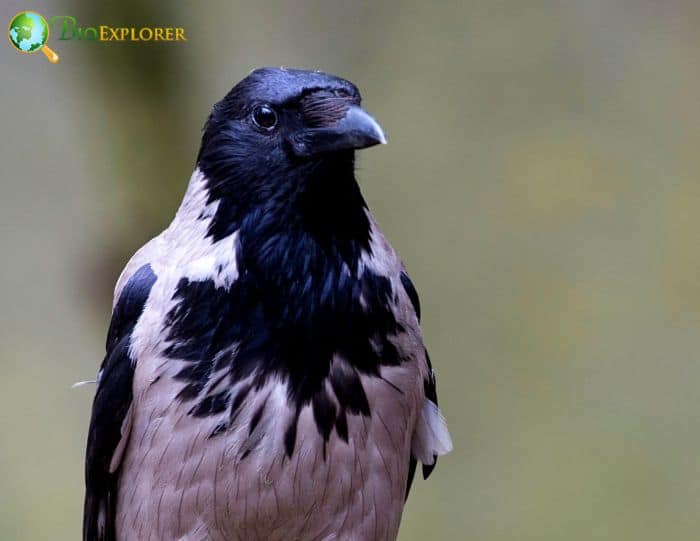
The hooded crow is a fascinating bird species with several interesting facts:
- Distribution: The hooded crow is widely distributed across Northern, Eastern, and Southeastern Europe, parts of the Middle East, and Northeast Africa.
- Appearance: This bird has ashy grey plumage, contrasting with black feathers on its head, throat, wings, tail, and thighs. Its bill, eyes, and feet are also black.
- Relationship with Carrion Crows: The hooded crow is so similar to the carrion crow in appearance and behavior that they were once considered geographical races of the same species. However, they were elevated to full species status in 2002.
- Behavior and Adaptability: Hooded crows are friendly birds that can be found living in pairs or small groups. They have a diverse diet, including dead animals, invertebrates, and grain, and they may even steal eggs from other birds’ nests. They have also become a common presence in inhabited areas, benefiting from the proximity of humans by feeding on waste and crop seeds[7].
- Conservation Status: The hooded crow is considered stable in Europe and has a conservation status of “Least Concern“. Its adaptable nature and ability to thrive in various environments contribute to its stable population.
- Migration and Sedentary Behavior: Northern European populations of hooded crows tend to migrate south during the winter. In contrast, southern populations remain mostly sedentary, remaining in their respective regions.
- Hybridization: Hybrids between hooded and carrion crows are fertile but may be less well-adapted compared to purebred birds.
- Observation: Hooded crows are particularly observable at sunset when they form large flocks during their travels.
The hooded crow’s wide distribution, adaptability, and ability to benefit from human presence make it an intriguing and successful bird species.
![]()






